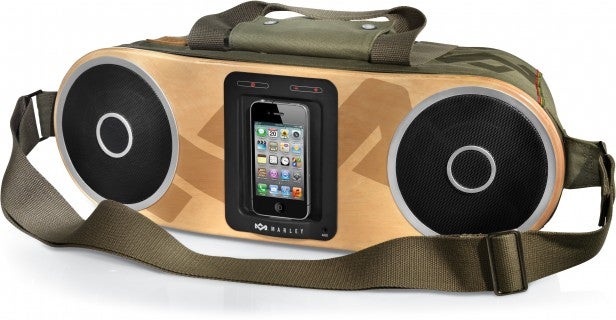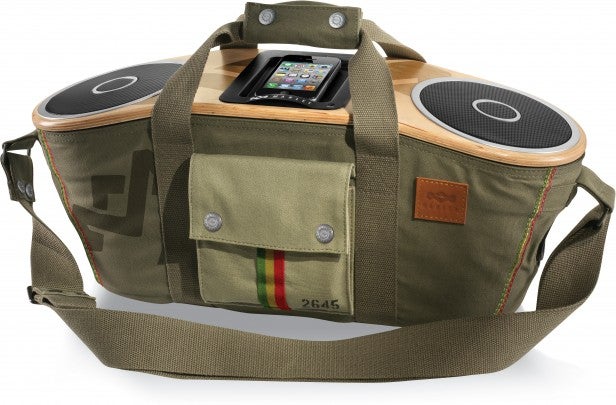House of Marley Bag of Rhythm Review
House of Marley Bag of Rhythm
The House of Marley enters the hugely competitive dock sector. Could you be loved?

Verdict
Pros
- Well made canvas carry bag
- Excellent playing reggae music
- Battery powered for listening on the move
Cons
- Over 7.5Kg with batteries
- Bass heavy and lacking clarity with other music types
- No wireless connectivity
- Total output (40W) below rivals
Key Specifications
- Review Price: £299.99
- 40W 2.0 Speaker System
- D Cell Battery Powered
- 3.5mm auxiliary jack
- Up to six hours battery life
- Carry handles
Celebrity endorsed products come in for a lot of abuse from audiophiles, but it is impossible to ignore their value in reaching a wider audience and educating them about the benefits of superior sound quality. At the forefront of these brands is The House of Marley, founded by the family of reggae legend Bob Marley, which releases audio products it claims are founded upon his same environmental and philanthropic beliefs. To date it has proved a hugely successful combination.
The Bag of Rhythm is The House of Marley’s first iPod/iPhone dock and, as could be expected, it is unmistakeably unique. No doubt launched to cash in with the arrival of summer, the Bag of Rhythm, more than any other dock we’ve seen recently, pushes its role as a portable sound system in the mould of yesteryear’s ghetto blasters. 
To (literally) carry this off the dock is wholly contained in an earthy canvass bag with hand and shoulder carry handles. This fits snugly, clipping to the dock with popper buttons and there are holes to avoid blocking the power port and bass output. Further pushing its claims for an outdoor life are useful pockets on both sides and a khaki colour scheme with numerous inevitable references to the Rastafarian flag.
As for the dock itself it looks somewhat like a skateboard attached to bongos and continues the naturalistic outdoor theme. The top surface is birch, the enclosure made from recycled plastic and notably the speakers are ceiling-facing, which assumes it will be positioned below you on the ground. Connectivity is kept to a minimum with just a 3.5mm auxiliary jack, no wireless (Bluetooth or AirPlay) and a snug iPhone/iPod dock that stops a connected device from falling out on the move (though excludes iPads). Controls are kept to a minimum too with only power, volume up and volume down buttons.
Batteries keep the Bag of Rhythm playing on the move. It swallows no less than six D cell batteries (not included), which The House of Marley says will last up to six hours. What is worth noting is the weight these batteries add. The shoulder strap makes the Bag of Rhythm relatively easy to carry, but at 6.8kg and roughly 100-150g per battery (depending on its type) you are looking at a product of around 7.5kg. 
So what about the audio itself? The Bag of Rhythm omits a dedicated bass driver, making for a 2.0 arrangement with 40 watts of total power (20 watts per channel). This is comprised of two 4.5in woofers and two 1in tweeters. Typically, The House of Marley isn’t subtle about the sound signature you can expect: “Using reggae music as the test by which all our products are made, bass is the first element we turn our attention to,” says the website. “The bass is the driving force. We want to hear it without distortion no matter how low it goes and we want it to hit hard. Every one of our in-ear and on-ear headphones and speakers are made for the biggest sounding reggae bass.”
The obvious question is whether this a good thing? The answer is: not always. Certainly it cannot be disputed that the Bag of Rhythm sounds excellent when on its own turf. Blasting out reggae is a heart-lifting experience with a fat bass, warm sound and (pun very much intended) bags of emotion. Where the problems start, however, is when you expose the dock to a wider acoustic palate.
With music where bass is less prominent, such as jazz, acoustic sessions or classical music the Bag of Sound struggles with clarity. It is so keen to try and throw bass at the slightest hint of anything with a low frequency that French horns or an oboe in a classic composition can instantly overpower the rest of the instruments. Furthermore in more complex music, such as the soundscapes of post rock bands like Explosions in the Sky or Godspeed You Black Emperor, the Bag of Rhythm struggles to do justice to the full frequency range creating a narrow sound lacking detail. 
These shortcomings are less exposed on bass-friendly dance and hip hop tracks, but – as with so many docks – stereo separation is extremely limited and you need to carefully consider the type of music you will play predominantly. You also need to consider how you will primarily use the Bag of Rhythm. Tempting as it is to dream of images of lying in the park with friends and the dock booming out beside you it is likely to spend considerable time in the house and, unless you place the dock on the floor, its ceiling facing speakers are not ideally positioned for home listening. There is a reason why all indoor docks have their speakers positioned horizontally.
As for battery life, this is hard to judge. Your mileage will vary depending on the type of batteries you buy, the playback volume and even type of music you play but four hours and above should be achievable to all. One frustration is the dock doesn’t charge rechargeable batteries when plugged into the mains. This makes sense as it would be impossible to distinguish between rechargeable and non-rechargeable batteries, but since the dock needs to be removed from its canvas bag to take them out the operation is a little laborious. A flap or panel as was fitted for the power and bass outputs would have been preferable.
There are other frustrations too. With no mute button, the volume controls are very slow to respond taking a full 20 seconds to mute the volume from maximum. This would be equally frustrating in the park or at home when the phone rings. It would also have been nice if The House of Marley had included a remote control or even basic Bluetooth wireless, without the latter your iPhone is somewhat exposed out in public. 
Lastly we come to price. As with any fashion brand there comes a premium and at a penny under £300 the Bag of Rhythm is no impulse buy. If you will use it largely at home then the £250 Monitor Audio i-deck 200 offers considerably better sound quality for less and for £350 the Arcam rCube also has superior audio as well as a built-in rechargeable battery that lasts up to eight hours in an 80 watt 2.1 dock that weighs only 5Kg.
Meanwhile, for those requiring true portability the £85 Pasce Minirig weighs just over 400g, outputs 15W, sounds glorious and lasts up to 60 hours – we’d buy two and link them together. Faced with these options there is little reason to do your Jammin’ here.
”’Verdict”’
The House of Marley has come out of the blocks flying. Its products have unique, yet instantly recognisable styling and the environmental and philanthropic beliefs it preaches are refreshing. Sadly the Bag of Sound is a case of style over substance. Its reggae focused sound signature makes it crass towards other forms of music with overpowered bass and a lack of detail. At over 7.5Kg with batteries it is also heavy despite the shoulder strap, there’s no wireless connectivity and at 40W it isn’t all that powerful for a dock this size. On the surface the Bag of Rhythm is a breath of fresh air, but in reality it is blown away by the competition. Will its youthful target market care? We suspect not.
Trusted Score
Score in detail
-
Design 7
-
Sound Quality 6
-
Features 6
-
Value 6
-
Usability 7

